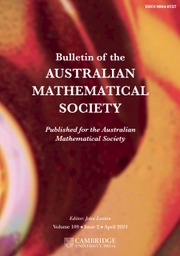No CrossRef data available.
Article contents
OPTIMAL INSDEL CODES FROM ALMOST MDS CODES
Published online by Cambridge University Press: 17 February 2025
Abstract
Determining the insdel distance of linear codes is a very challenging problem. Recently, Ji et al. [‘Strict half-Singleton bound, strict direct upper bound for linear insertion-deletion codes and optimal codes’, IEEE Trans. Inform. Theory 69(5) (2023), 2900–2910] proposed their strict half-Singleton bound for linear codes that do not include the all-one vector. A natural question asks for linear codes with both large Hamming distance and insdel distance. Almost maximum distance separable (MDS) codes are a special kind of linear code with good Hamming error-correcting capability. We present a sufficient condition for the insdel distance of almost MDS codes to be bounded by the strict half-Singleton bound. In addition, we construct a class of two-dimensional near MDS codes that achieve the strict half-Singleton bound using twisted Reed–Solomon codes. Finally, we present a construction of optimal almost MDS insdel codes from Reed–Solomon codes for large dimensions.
Keywords
- Type
- Research Article
- Information
- Copyright
- © The Author(s), 2025. Published by Cambridge University Press on behalf of Australian Mathematical Publishing Association Inc.
Footnotes
This work was supported by the National Natural Science Foundation of China under grant numbers 12171309 and 12271084.



